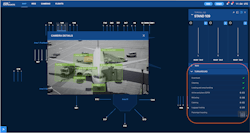In a data-driven world, more information provides opportunities to be efficient. ADB SAFEGATE is helping deliver key information to ground personnel while keeping them connected with airport and airline officials for improved operations on the ramp.
Working in tandem with its Safedock Advanced Visual Docking Guidance Systems (A-VDGS), ADB SAFEGATE’s SafeControl Apron Management (SAM) system uses real-time intelligence to optimize the use of resources and improve the predictability of events on the apron.
As a result, aircraft docking, turnaround and pre-departure sequencing processes can all be streamlined to improve airport and airline performance via faster gate turns, reduced delays, less ramp congestion and increased productivity.
Previously, ADB SAFEGATE offered a gate operating system designed to control, monitor and maintain the Safedock A-VDGS. Niclas Svedberg, ADB SAFEGATE’s global product manager for the SafeControl Apron Management, explains the SAM system is capable of monitoring all gate activity and managing the entire process of arriving and departing aircraft.
“It can be used to manage all stands/gates – equipped with A-VDGS and ‘marshalled only’ stands,” Svedberg says. “SAM is the natural connection point for integrating all systems and equipment in the apron area, including flight feeds and other systems such as weather systems, baggage handling systems, resource/asset management systems and surveillance systems.”
Ramp Connectivity
Automated aircraft docking via Safedock A-VDGS is at the heart of the SAM system, Svedberg notes. The strategic location at each gate allows the A-VDGS to be used as intelligent sensors to track the progress of the aircraft turnaround and the position of aircraft in the gate area.
SAM shares information from other connected systems with the Safedock A-VDGS, such as flight feeds and weather information like lightning warnings. SAM also tracks and reports aircraft movements, gate status and turn milestones, including block-on/block-off time and use of ground support equipment (GSE). It then relays that data back to airport and airline systems.
“SAM monitors all connected systems, tracks history and reports analytics that can be used by airport operators to measure compliance to procedures and performance to improve operations,” explains Svedberg.
“SAM supports collaborative decision-making to optimize ground operations,” he continues. “Real-time gate intelligence and accurate flight information is shared with airport, airline and ramp and air traffic control systems.”
Integration with other systems allows SAM to inform ground personnel of critical arrival and departure information via Safedock’s LED ramp information display system (RIDS).
“Airport and airlines can use actual and automated block times for reporting of on-time performance (OTP),” adds Svedberg. “Airports have the ability to track gate use by user for better tracking and analysis.”
Standard SAM features include gateway to external systems; automated docking start-ups; real-time status view of each gate; gate adjacency rules; support of MARS stands; camera view of the ramp; error messages and alerts; tracking and reporting turnaround progress; tracking and reporting block times; tracking and reporting passenger boarding bridge position; tracking and reporting GSE use; ramp closed message when lightning is detected; automated and free text RIDS messages; central maintenance for software updates and configuration changes; access for remote support; and user management.
“By connecting systems involved in the turnaround process, vital information is shared to increase situational awareness and allow the right decisions or corrective actions to be taken to ensure smooth and safe operations,” says Svedberg. “By managing the equipment and resources involved in the turnaround process, and by tracking the progress of the same, SAM can identify interruptions of the workflow and produce alerts to enable preventive actions and to avoid delays.”
Integrations can include flight information/airport operational database (AODB), video analytics/AI and Advanced Surface Movement Guidance and Control System (A-SMGCS) is also available. The A-SMGCS integration uses the A-VDGS as sensors to improve surveillance and ATC situational awareness of aircraft approaching/departing the stand by eliminating black spots close to the terminal where coverage is often not good. Controllers are informed in real time as inbound aircraft clear the taxiway, enabling better use of taxiways and preventing tail accidents. On pushback, the system provides visual clarification of departure clearance to pilots and sends alerts of unauthorized pushbacks to controllers.
“Each SAM system is designed to meet the needs of the customer, so every system can be different with different integrations,” Svedberg says.
SAM and the Safedock A-VDGS provide several safety features designed to protect aircraft, GSE and personnel.
“Automating the aircraft docking process creates a safer operation by increasing situational awareness to reduce the opportunity for error,” says Svedberg. “Allowing pilots to self-park not only reduces taxiway congestion and speeds up the docking process, but it keeps ground crew out of the danger zone and better positioned to service aircraft.”
Safedock A-VDGS verifies aircraft/gate compatibility and compatibility with aircraft at adjacent gates. As a result, aircraft docking cannot commence if it is not safe.
The A-VDGS monitors the aircraft approach to ensure aircraft enter on the correct centerline and at the correct angle so that wingtip clearances are maintained. Safedock A-VDGS reduces human error and accidents by scanning the apron to detect items such as baggage trailers or suitcases, as well as personnel in the wrong place.
“The Safedock system is designed to provide active guidance to pilots to support safe, efficient and precise automated aircraft parking during any weather condition where the operation of aircraft is allowed – even during thunderstorms when personnel or ground crew cannot be present,” Svedberg says. “The Safedock system uses an infrared laser and a 3D-scanning technique to track the position of an arriving aircraft to provide safer, more efficient and more accurate aircraft dockings than can be provided manually or through other types of systems.”
An interface with the passenger boarding bridge (PBB) lets ground personnel and the A-VDGS know that the PBB is in a safe position and not in the way of an arriving aircraft.
“A standard interlock feature between the Safedock A-VDGS and the PBB confirms that the bridge is in its safe/parked position and that the docking process may commence,” Svedberg says. “This requires that the PBB has the capability to share its location status and send a signal to the Safedock system. An incorrect PBB position will result in a ‘WAIT/BRIDGE IN’ message on the Safedock display. Docking will commence when the PBB has returned to the safe area.
“If the bridge is not capable of reporting its position, the Safedock can use its apron scan feature to detect a PBB in the way of an arriving aircraft,” he continues. “If the PBB is in the way of an arriving aircraft during the docking, a ‘BLOCKED’ message is displayed and the docking can only be continued when the PBB is returned to a safe position.”
In addition to knowing whether the bridge is in its home or pre-position, it is also of interest for the SAM system to know when the ‘auto leveler’ is deployed to determine when the bridge is connected to or becomes disconnected from the aircraft, Svedberg explains.
“When an aircraft is parked, the Safedock will send detailed information about the actual stop position of the aircraft to enable auto-drive functions,” he says.
Updates Through Feedback
The SafeControl Apron Management was first delivered to the Dallas-Fort Worth International Airport in late 2011 and the full product release was in 2012, according to Svedberg. Increased interest from airports and airlines in apron management intelligence led to the development of SafeControl Apron Management as ADB SAFEGATE’s customers sought more information and increased functionality.
There have been numerous updates since the original launch, including a new web-based SAM Human-Machine Interface (HMI).
Input from airport and airline customers has been key to the development of SAM and many real-world scenarios have prompted new SAM features/functionality. Examples of the new functionalities that have been developed to meet real-world needs of customers include such things as web-based SAM client; integration with airport CCTV systems; mimic of Safedock display on SAM client during the docking sequence; and performance monitoring and analytics.
Other features being developed include integration with surface surveillance to track moving aircraft on SAM client; integration with video AI for gate activity tracking; and IOT for FSE equipment asset management.
“ADB SAFEGATE worked closely with American Airlines to develop and deliver the first multi-station SAM system,” notes Svedberg. “The multi-station system gives American a centralized view of their major hub operations and provides the ability to monitor gate activity and control A-VDGS functions from one system. The system also includes reporting and data analytics capabilities that were important to the airline.”
The Safedock A-VDGS is in use at more than 11,000 gates worldwide while SafeControl Apron Management and the previous iteration are used at more than 150 airports globally.
“The SAM system offers insight to airports, airlines and ground handlers,” Svedberg says. “The system provides consistent messaging on multiple platforms and medias about the ongoing operation at each gate.
“By linking the staff rostering system to the SAM, a ground handler can have an up-to-date list of gates that need to be serviced and quick updates on delays, gate changes and cancellations or diversions.”
About the Author
Josh Smith
Editor
Josh Smith served as editor of Ground Support Worldwide as editor from 2016 through 2024. He oversaw production of the print magazine, created GSW's newsletters on a daily basis, and updated the latest news on AviationPros.com.

